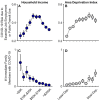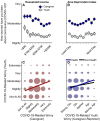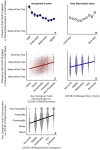Resilience to COVID-19: Socioeconomic Disadvantage Associated With Positive Caregiver-Youth Communication and Youth Preventative Actions
- PMID: 35223717
- PMCID: PMC8865385
- DOI: 10.3389/fpubh.2022.734308
Resilience to COVID-19: Socioeconomic Disadvantage Associated With Positive Caregiver-Youth Communication and Youth Preventative Actions
Abstract
Socioeconomic disadvantage is associated with larger COVID-19 disease burdens and pandemic-related economic impacts. We utilized the longitudinal Adolescent Brain Cognitive Development Study to understand how family- and neighborhood-level socioeconomic disadvantage relate to disease burden, family communication, and preventative responses to the pandemic in over 6,000 youth-caregiver dyads. Data were collected at three timepoints (May-August 2020). Here, we show that both family- and neighborhood-level disadvantage were associated with caregivers' reports of greater family COVID-19 disease burden, less perceived exposure risk, more frequent caregiver-youth conversations about COVID-19 risk/prevention and reassurance, and greater youth preventative behaviors. Families with more socioeconomic disadvantage may be adaptively incorporating more protective strategies to reduce emotional distress and likelihood of COVID-19 infection. The results highlight the importance of caregiver-youth communication and disease-preventative practices for buffering the economic and disease burdens of COVID-19, along with policies and programs that reduce these burdens for families with socioeconomic disadvantage.
Keywords: COVID-19; adolescence; caregivers; pandemic; socioeconomic factors.
Copyright © 2022 Marshall, Hackman, Baker, Breslin, Brown, Dick, Gonzalez, Guillaume, Kiss, Lisdahl, McCabe, Pelham, Sheth, Tapert, Rinsveld, Wade and Sowell.
Conflict of interest statement
FCB and OK are employed by SRI International, a non-profit research organization. The authors declare that this study received funding from the National Institutes of Health, the National Science Foundation, and Children and Screens: Institute of Digital Media and Child Development Inc. The funders were not involved in the study design, collection, analysis, interpretation of data, and the writing of this article or the decision to submit it for publication. All authors declare no other competing interests.
Figures






Update of
-
Resilience to COVID-19: Socioeconomic Disadvantage Associated With Higher Positive Parent-youth Communication and Youth Disease-prevention Behavior.Res Sq [Preprint]. 2021 Apr 23:rs.3.rs-444161. doi: 10.21203/rs.3.rs-444161/v1. Res Sq. 2021. Update in: Front Public Health. 2022 Feb 09;10:734308. doi: 10.3389/fpubh.2022.734308. PMID: 34013256 Free PMC article. Updated. Preprint.
References
Publication types
MeSH terms
Grants and funding
- U01 DA041174/DA/NIDA NIH HHS/United States
- U01 DA041048/DA/NIDA NIH HHS/United States
- U01 DA041093/DA/NIDA NIH HHS/United States
- U01 DA041106/DA/NIDA NIH HHS/United States
- U01 DA050989/DA/NIDA NIH HHS/United States
- U01 DA041089/DA/NIDA NIH HHS/United States
- U24 DA041123/DA/NIDA NIH HHS/United States
- U01 DA041134/DA/NIDA NIH HHS/United States
- U24 DA041147/DA/NIDA NIH HHS/United States
- U01 DA050987/DA/NIDA NIH HHS/United States
- U01 DA041022/DA/NIDA NIH HHS/United States
- U01 DA051037/DA/NIDA NIH HHS/United States
- U01 DA051016/DA/NIDA NIH HHS/United States
- U01 DA041148/DA/NIDA NIH HHS/United States
- U01 DA050988/DA/NIDA NIH HHS/United States
- UL1 TR001855/TR/NCATS NIH HHS/United States
- U01 DA041028/DA/NIDA NIH HHS/United States
- U01 DA041117/DA/NIDA NIH HHS/United States
- U01 DA051018/DA/NIDA NIH HHS/United States
- U01 DA051038/DA/NIDA NIH HHS/United States

